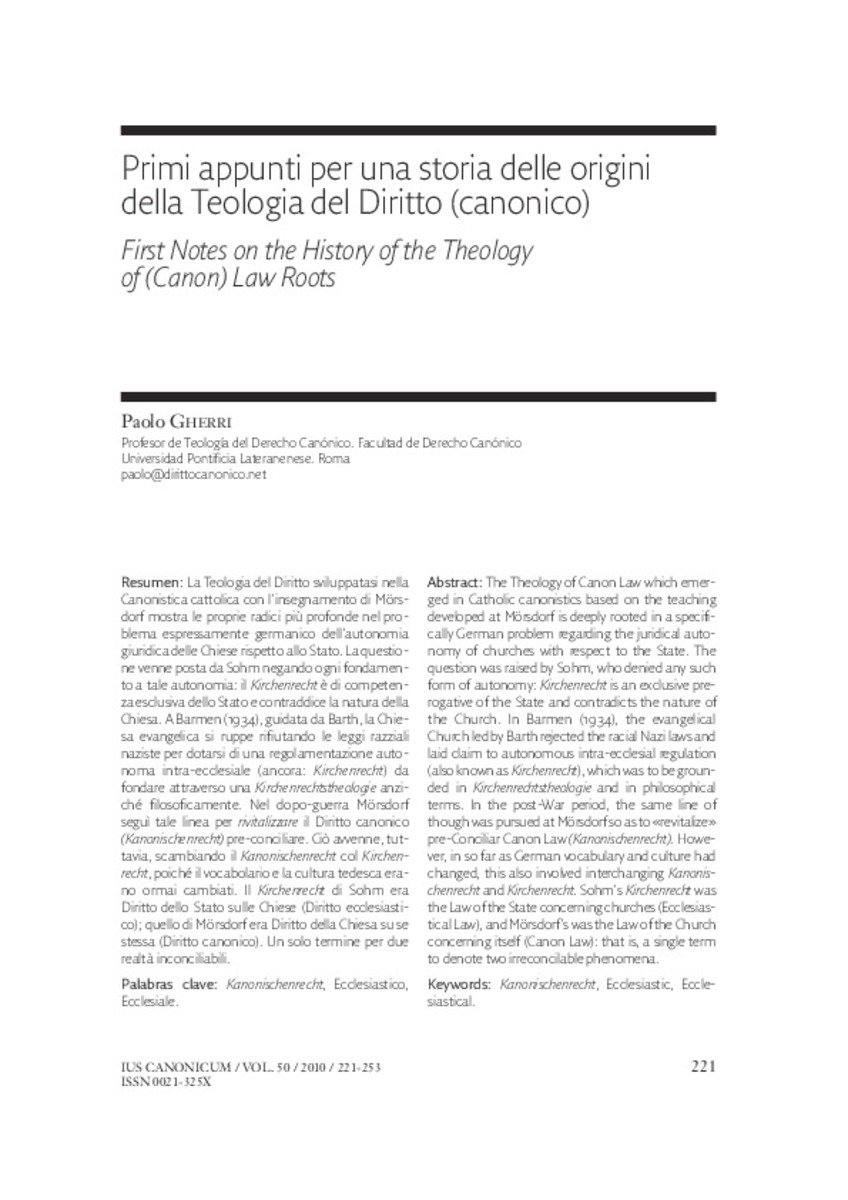Registro completo de metadatos
| Campo DC | Valor | Lengua/Idioma |
|---|---|---|
| dc.creator | Gherri, P. (Paolo) | - |
| dc.date.accessioned | 2014-08-12T11:56:39Z | - |
| dc.date.available | 2014-08-12T11:56:39Z | - |
| dc.date.issued | 2010 | - |
| dc.identifier.citation | IUS CANONICUM, 2010, 50, N. 99, págs. 221-253. | es_ES |
| dc.identifier.issn | 0021-325X | - |
| dc.identifier.uri | https://hdl.handle.net/10171/36316 | - |
| dc.description.abstract | La Teologia del Diritto sviluppatasi nella Canonistica cattolica con l’insegnamento di Mörsdorf mostra le proprie radici più profonde nel problema espressamente germanico dell’autonomia giuridica delle Chiese rispetto allo Stato. La questione venne posta da Sohm negando ogni fondamento a tale autonomia: il Kirchenrecht è di competenza esclusiva dello Stato e contraddice la natura della Chiesa. A Barmen (1934), guidata da Barth, la Chiesa evangelica si ruppe rifiutando le leggi razziali naziste per dotarsi di una regolamentazione autonoma intraecclesiale (ancora: Kirchenrecht) da fondare attraverso una Kirchenrechtstheologie anziché filosoficamente. Nel dopo-guerra Mörsdorf seguì tale linea per rivitalizzare il Diritto canonico (Kanonischenrecht) preconciliare. Ciò avvenne, tuttavia, scambiando il Kanonischenrecht col Kirchenrecht, poiché il vocabolario e la cultura tedesca era- no ormai cambiati. Il Kirchenrecht di Sohm era Diritto dello Stato sulle Chiese (Diritto ecclesiastico); quello di Mörsdorf era Diritto della Chiesa su se stessa (Diritto canonico). Un solo termine per due realtà inconciliabili. | es_ES |
| dc.description.abstract | The Theology of Canon Law which emerged in Catholic canonistics based on the teaching developed at Mörsdorf is deeply rooted in a specifically German problem regarding the juridical autonomy of churches with respect to the State. The question was raised by Sohm, who denied any such form of autonomy: Kirchenrecht is an exclusive prerogative of the State and contradicts the nature of the Church. In Barmen (1934), the evangelical Church led by Barth rejected the racial Nazi laws and laid claim to autonomous intraecclesial regulation (also known as Kirchenrecht), which was to be grounded in Kirchenrechtstheologie and in philosophical terms. In the post-War period, the same line of though was pursued at Mörsdorf so as to «revitalize» pre-Conciliar Canon Law (Kanonischenrecht). However, in so far as German vocabulary and culture had changed, this also involved interchanging Kanonischenrecht and Kirchenrecht. Sohm’s Kirchenrecht was the Law of the State concerning churches (Ecclesias- tical Law), and Mörsdorf’s was the Law of the Church concerning itself (Canon Law): that is, a single term to denote two irreconcilable phenomena. | es_ES |
| dc.language.iso | ita | es_ES |
| dc.publisher | Instituto Martín de Azpilcueta | es_ES |
| dc.rights | info:eu-repo/semantics/openAccess | es_ES |
| dc.subject | Kanonischenrecht | es_ES |
| dc.subject | Ecclesiastico | es_ES |
| dc.subject | Ecclesiale | es_ES |
| dc.subject | Ecclesiastic | es_ES |
| dc.subject | Ecclesiastical | es_ES |
| dc.title | Primi appunti per una storia delle origini della Teologia del Diritto (canonico) | es_ES |
| dc.title.alternative | First Notes on the History of the Theology of (Canon) Law Roots | es_ES |
| dc.type | info:eu-repo/semantics/article | es_ES |
| dc.identifier.doi | 10.15581/016.50.2658 | es_ES |
Ficheros en este ítem:
Estadísticas e impacto
Los ítems de Dadun están protegidos por copyright, con todos los derechos reservados, a menos que se indique lo contrario.






